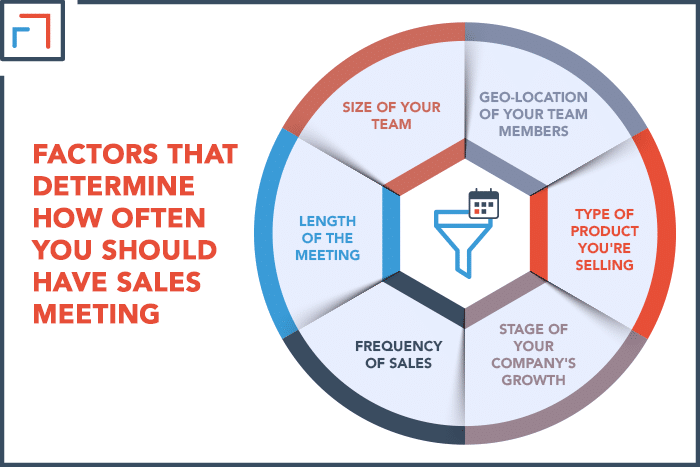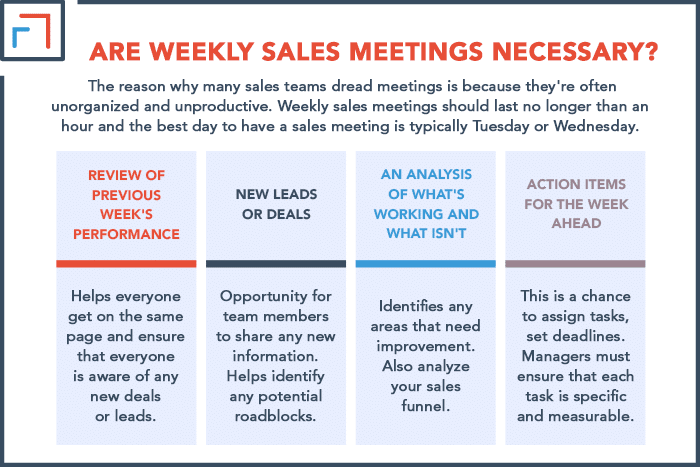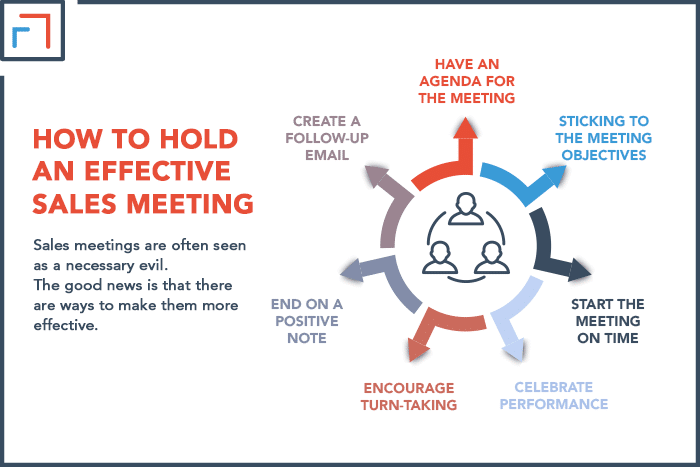Sales meetings are an essential part of any business. They provide a forum for the sales team to share information, learn from each other, and gain motivation. But how often should you have them?
Established businesses should have a sales meeting at least once a month. However, weekly sales meetings may be necessary for startups and businesses in the early growth stage. Some companies hold sales meetings daily, but this method may not be necessary or practical for most businesses.
That’s the simple answer, but other factors must be considered when deciding how often to have sales meetings. It all depends on the goals of the business and the needs of your team. So let’s dive into some determining factors.
Factors that Determine How Often You Should Have Sales Meeting
There is no one-size-fits-all answer to determine how often sales meetings should be held.
The frequency of your sales meetings will depend on several factors. Some of them are:
- Size of your team
- The geographical location of your team members
- The type of product you’re selling
- Stage of your company’s growth
- Your performance/ frequency of sales
- Length of the meeting
Now that we have highlighted these factors, it’s time to look at each one in detail.
1. Size of Your Team
The size of your team is an important factor to consider when deciding how often to have sales meetings.
If you have a large team, you may need frequent meetings so that everyone has a chance to share their ideas and be heard.
In that case, weekly or bi-weekly meetings may be the best. Then again, if the team is too large, it may be hard to coordinate frequent meetings.
In this case, breaking up into smaller units may be helpful.
On the other hand, if you have a small team, you may get by with monthly or even quarterly sales meetings.
In the time between meetings, the members should still keep in touch with each other to track their progress.
The key is to find a balance that works for your team.
2. Geo-Location of Your Team Members
Although some sales teams still meet in person, many now work remotely because of the pandemic and other factors.
This has changed the landscape of how and when companies hold sales meetings.
With team members in different time zones, finding a time that works for everyone can be difficult.
If you are dealing with different time zones, you can hold two monthly sales meetings that accommodate different regions.
This way, everyone has a chance to participate in the meeting without having to rearrange their schedules too often.
If your meetings must be physical, you can consider the geographical location of your team members.
For teams working within the same city, weekly or bi-weekly meetings may be ideal.
Monthly or quarterly meetings may be more practical if your team is spread across the country or the globe.
3. Type of Product You’re Selling
It goes without saying that the type of product you are selling will impact how often you hold sales meetings.
You’ll likely need more time to close the deal if you’re selling a high-priced item, such as a car or house.
In that case, monthly or quarterly meetings may be best to update your team on your progress and get their input.
You may close deals more quickly if you’re selling lower-priced items, such as books or jewelry.
In that case, weekly or bi-weekly meetings may be best to keep everyone informed.
Because all meetings cost time and money, it’s crucial to find a balance that doesn’t hurt your bottom line.
4. Stage of Your Company’s Growth
It’s a mistake to assume that all companies – no matter their growth stage – should have sales meetings at the same frequency.
Monthly sales meetings may be sufficient for established businesses with structures in place.
On the other hand, if you have a startup or are in the early stages of growth, you may need to hold weekly sales meetings.
For example, when a company is just starting out, the sales team may be small, and meeting weekly allows everyone to stay on the same page.
There are a lot of kinks to iron out at this stage, so frequent check-ins are essential.
As the company grows, the team may get larger, and meeting bi-weekly or monthly may make more sense.
5. Frequency of Sales
How often do you close deals? Whether it’s daily, weekly, or monthly, the frequency of your sales will impact how often you need to hold sales meetings.
If you’re closing deals daily, you’ll likely need frequent meetings to update your team on your progress and get their input.
This factor also depends on the type of product you’re selling and the stage of your company’s growth.
It might take more time to convert if you’re selling a high-priced item, such as cars or houses.
However, if the low frequency of sales emanates from poor team performance, more frequent sales meetings may be necessary to get the team back on track.
6. Length of the Meeting
Let’s say Company A holds a two-hour meeting every week, while Company B holds a one-hour session bi-weekly.
Which company is more likely to have productive meetings?
It’s not the frequency of the meetings that matter, but rather the length and quality of the meetings. A longer meeting does not necessarily mean it will be more productive.
In fact, longer meetings are more likely to be less productive as team members lose focus and become distracted.
Although you may need to hold longer meetings from time to time, don’t make it a habit.
People will do better work if they can do their jobs rather than waste time in long meetings.
If you find that your meetings are regularly going over the allotted time, it’s a sign that you need to re-evaluate the structure and purpose of your meetings.

Are Weekly Sales Meetings Necessary?
Weekly sales meetings can be helpful if they’re done right. The reason why many sales teams dread meetings is because they’re often unorganized and unproductive.
Weekly sales meetings should last no longer than an hour. They tend to drag on if they’re unfocused and lack a clear purpose.
The best day to have a sales meeting is typically Tuesday or Wednesday.
This gives the team time to prepare for the week ahead and review their performance from the previous week.
What Should a Weekly Sales Meeting Include?
If you want your weekly sales meeting to be productive, you should include the following:
- A review of the previous week’s performance
- Discussion of any new leads or deals
- An analysis of what’s working and what isn’t
- Identification of areas for improvement
- Action items for the week ahead
This outlines some of the items to include in your meeting. Let’s look at how to structure each element.
1. Review of Previous Week’s Performance
The first item on the agenda should be a review of the previous week’s performance.
This will help everyone get on the same page and ensure that everyone is aware of any new deals or leads.
Some important metrics to discuss include:
- Number of new leads
- Deals closed
- Deals in the pipeline
Each team member should be prepared to discuss their performance from the previous week. This will help identify any areas where someone may need assistance.
2. New Leads or Deals
Taking a proactive approach to sales is essential for success. Therefore, the second item on the agenda should be information about any new leads or deals.
This is an opportunity for team members to share any new information they may have. It’s also a chance to identify any potential roadblocks.
The agenda can be guided by questions such as:
- Who are the new leads?
- What products or services are they interested in?
- When is the expected close date?
These questions will help the team to know where to focus their attention. Apart from that, a futuristic approach provides essential information for sales projection.
3. An Analysis of What’s Working and What Isn’t
Have you ever felt like you’re spinning your wheels but not getting anywhere? It’s important to take a step back and analyze what’s working and what isn’t.
This can be done by looking at the following metrics:
- Conversion rate
- Average deal size
- Churn rate
By analyzing these metrics, you’ll identify any areas that need improvement.
For example, if the conversion rate is low, you’ll know that you need to work on your sales process.
You should also analyze your sales funnel to see where the majority of deals are falling through. This will help you to focus your attention on the right areas.
4. Action Items for the Week Ahead
This is a chance to assign tasks and set deadlines. Managers must ensure that each task is specific and measurable.
Some things to keep in mind when assigning tasks include:
- Who is responsible for the task?
- When is the deadline?
- What are the deliverables?
By clearly understanding these things, you can hold team members accountable and ensure that tasks are completed on time.

How to Hold an Effective Sales Meeting?
Have you ever been in a sales meeting that felt like a waste of time? If so, you’re not alone. Sales meetings are often seen as a necessary evil.
The good news is that there are ways to make them more effective.
1. Have an Agenda for the Meeting
Imagine you’re in a sales meeting. As you go around the room, each person gives an update on their progress for the month.
After an hour, you’ve learned that John closed two deals, Jane closed one sale, and Joe didn’t close any deals.
The meeting ends, and everyone goes back to their work. Did that meeting serve a purpose? Probably not.
A better way to structure the meeting would be to have a plan with specific topics to discuss.
For example, you could discuss the progress of a particular deal or brainstorm ideas for a new marketing campaign.
By having an agenda, you can ensure that each meeting has a purpose and is productive.
Although there is a place for giving reports in a sales meeting, it shouldn’t be the only thing discussed.
2. Sticking to the Meeting Objectives
Having a meeting agenda is a good start, but it’s not enough. You also must ensure that the meeting stays on track and that each agenda item is covered.
One way to do this is to appoint someone to keep time and keep the discussion moving.
This person’s job is to ensure that each agenda item is covered and the meeting ends on time.
Most people are fine with a meeting that wraps up early, but it’s painful if the meeting drags on too long.
Although it’s essential to stay within your time limits, you also need to be flexible with the topics of conversation.
If a discussion is going well and the team is engaged, there’s no need to push on to the next topic if you still have things to say.
Make a meeting outline, but feel free to adjust the amount of time spent on each subject.
3. Celebrate Performance
Most sales team meetings focus on what isn’t working and what needs to be improved.
While it’s important to identify areas for improvement, you also need to celebrate the team’s successes. Building morale is essential!
Ensure you set aside time to discuss deals that were closed and performance goals that were met.
This will help create a positive environment and will motivate the team to keep up the good work.
It doesn’t have to feel like a drag to attend sales meetings. Appreciating members that excel can go a long way.
4. Start the Meeting on Time
This one might seem like a no-brainer, but you’d be surprised how often sales meetings start late. If you’re leading the meeting, make sure you start on time.
You set the tone for the rest of the meeting by being punctual. It also shows that you respect everyone’s time and are serious about making the meeting productive.
When people see that the leader of the meeting is on-time, they’re more likely to be engaged.
5. Encourage Turn-taking
When people feel like they have the opportunity to share their ideas, they’re more likely to participate in the discussion.
Encourage turn-taking by going around the room and asking each person for input on each agenda item.
This will help ensure that everyone is engaged in the discussion and all voices are heard.
Of course, some members may tend to dominate the conversation. In these cases, you may need to step in and limit their speaking time.
However, you should do this courteously.
6. End on a Positive Note
Ending the meeting on a positive note is just as important as starting it on a positive note.
After you’ve discussed the agenda items and identified areas for improvement, finish the meeting by discussing something that went well or assigning action items.
By ending the meeting positively, you’ll leave the team feeling motivated and ready to take on the next challenge.
7. Create a Follow-up Email
After the meeting, send out a follow-up email with a recap of what was discussed and any assigned action items.
This will ensure that everyone is on the same page and that nothing falls through the cracks.
Plus, it’ll give people something to refer back to if they need to review what was discussed in the meeting.
In case of any absenteeism, the follow-up email also ensures that they are up-to-date. The email should include critical decisions, action items, and next steps.

Key Takeaways
Although sales meetings are often seen as a waste of time, they can be beneficial if done correctly.
Depending on the size of your team and the nature of your business, you should aim to have a weekly or bi-weekly sales meeting.
Ideally, these meetings will last no longer than an hour.
They should review the previous week’s performance, discuss any new leads or deals, and identify areas that need improvement.
By following these tips, you can ensure that your sales meetings are productive and beneficial for your whole team.
